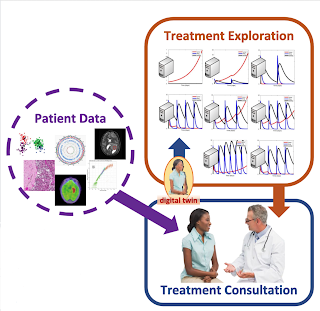Design thinking in Health Data Science
A group of Graduate students at the Georgetown HIDS program applying design thinking to Health data
"Make it simple but significant" -- Don Draper, a fictional character on the AMC's TV Show Mad Men. We could easily attribute Don's success with his advertising campaigns to meticulous application of design thinking.
Design thinking is a breakthrough model for human-centered innovation and problem solving where multi-disciplinary teams work iteratively to rapidly prototype products. This process of 1. Need finding 2. Ideation 3. Prototyping 4. Testing 5. Implementing and then back to 1. Need finding has been used across sectors to solve complex problems such as redesigning school curriculum to connect students to the world outside classrooms and designing future aircraft cabins. Last week, our students learned that applying design thinking to healthcare can improve patient and provider experiences as well as reduce medical errors, especially in this day and age of information overload.
Learning EMRs
Can Electronic Medical Records learn as we go to become more user-friendly? Healthcare systems require design thinking to improve the user experience for both patients and providers but these user groups are often ignored when software systems are developed. This results in lack of adoption of systems or extensive training periods. To avoid this issue, Dr. Visweswaran and colleagues at UPMC are developing a Learning Electronic Medical Record (LEMR) that learns how providers want information presented to them in a context-sensitive and concise fashion. He discussed, with our students (pictured above), how they trained predictive models for 80 different target variables (glucose levels, daily intake and output, total protein etc) that physicians use in an ICU EMR and organized them based on his/her information seeking behavior, thus reducing their cognitive burden.Patient Safety
Recent studies show that medical errors are the third leading cause of death in the US. A young women recovering well after transplant surgery dies just days later due to intra abdominal hemorrhage and cardiac arrest. Autopsy revealed that a needle inserted for a test grazed the liver causing the rupture and death. Human error is inevitable. Can design thinking help? Systems cab be designed to take into account human limitations. Perhaps a well trained AI-guided robotic surgery could have saved this young women's life?We are fortunate to work hand-in-hand with our clinical partners at MedStar Health who are leading patient safety programs such as CANDOR (Communication and Optimal Resolution). These programs are addressing many of these important issues around patient safety and quality of care with innovative methods including design thinking.
Our graduate students will take a deeper dive into design thinking during their Summer intensive learning class on Human Factors Engineering and design led by Dr. Kristen Miller at the MedStar's National Center for Human Factors in Healthcare.
Let's continue the conversation. Please share your comments on this topic.




Comments
Post a Comment